Mortgage Borrowers May Be Leaving Money on the Table by Using Less Effective Mortgage Shopping Strategies

Findings from the Fannie Mae November Topic Analysis Report suggest that consumers could save money and find a more financially sustainable mortgage product if they shopped more effectively. The failure to shop effectively means that consumers may not be taking full advantage of the unprecedentedly low interest rates offered today. In particular, nearly half of all lower income mortgage borrowers say they obtained only one quote when shopping for their current mortgage, a practice that may cost borrowers $1,000 or more in closing costs, according to recent research.1 Academic research also suggests that the risk of overpaying for a mortgage is higher among lower income borrowers.
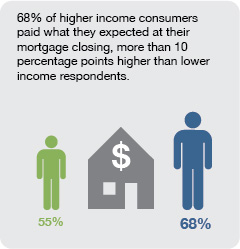
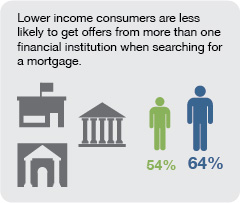
![]()
Consumers who undertake the mortgage shopping process without a thorough evaluation of their options may risk selecting a more costly mortgage, or worse, a financially unsustainable one. Survey results and other academic research suggest that improved consumer understanding and a better comparison of mortgage options across all consumers may provide financial benefit in the mortgage shopping process. This is particularly the case among lower income consumers (defined for the purposes of this research as less than $50,000 in annual total family income; higher income is defined as greater than $100,000 in annual total family income).
It Pays To Shop Around
Research done for the Department of Housing and Urban Development suggests that borrowers who obtain multiple mortgage broker quotes can save $1,000 or more in closing costs. Additional research suggests that borrowers with a better understanding of loan terms may take out lower-cost mortgages.2 However, research also suggests that many borrowers, particularly those falling in lower income brackets, do not fully understand their mortgages and can end up paying higher costs as a result.3, 4, 5
National Housing Survey data also reveal challenges with mortgage shopping and understanding across all consumers, as well as notable differences in shopping behaviors across income levels. In our statistical significance testing, income stood out as a key differentiator of shopping behavior among all demographic categories, including age, education, income, race, and whether the respondent was a first-time homebuyer. To further explore the mortgage shopping and understanding issues identified in previous academic research and in the National Housing Survey data, our analysis examines variation in mortgage shopping approaches and mortgage understanding across income levels.
How Do Consumers Shop for a Mortgage?
Survey results show that consumers do not always thoroughly evaluate their mortgage options before obtaining a mortgage.
Our National Housing Survey data show that, when choosing their mortgage lender, lower income respondents are more likely to be influenced by mortgage brokers and real estate agents. More than 3 out of 4 higher income respondents said that competitive offers would have a major influence on their choice, which is more than 20 percentage points higher than lower income respondents. Reputation is important to all income groups: more than 2 out of 3 said it would be a major factor in lender choice.
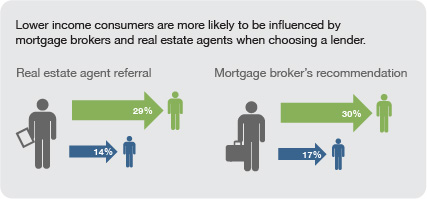
![]()
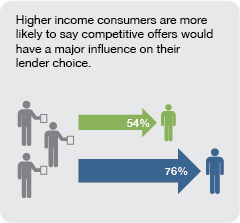
![]()
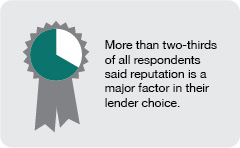
Data from the survey also show that higher income respondents are more comfortable using technology in the mortgage shopping process. They are more likely than lower income respondents to say they used the phone and online search to obtain mortgage offers, and are more comfortable using mobile devices to research homes for sale, lenders, and rates. However, across all income groups, consumers are less comfortable obtaining mortgage quotes or the mortgage itself using a mobile device.
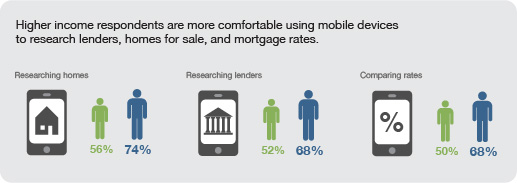
![]()
Most consumers do shop around for their mortgage, but lower income respondents are less likely than higher income respondents to obtain more than one offer. Sixty-four percent of higher income respondents obtained offers from more than one financial institution compared to only 54 percent of lower income respondents.6
Do Consumers Understand Mortgage Products and Costs?
Survey results find that a substantial portion of all consumers do not understand key mortgage elements.
We asked respondents to estimate the maximum percentage by which the monthly adjustable-rate mortgage (ARM) payment can increase over the life of the loan. Forty-one percent said they didn’t know. The average response among those who did offer a guess was about 10 percent, well out of the range of our calculation of 50 percent or more.7 Current mortgage borrowers’ average estimates were even further away from our calculation.
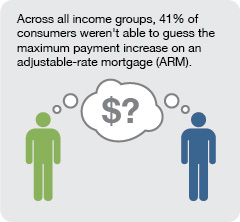
![]()
When asked about their own mortgage, higher income consumers are more likely to say they paid what they expected at their mortgage closing.
Consumers who more fully understand the mortgage choices available are more likely to be better able to make effective trade-offs between cost, risk, and service offerings. This could help make for more satisfied consumers and help prevent future delinquencies, defaults, and foreclosures.
Steve Deggendorf
Director, Business Strategy
Economic & Strategic Research
November 27, 2012
Opinions, analyses, estimates, forecasts and other views of Fannie Mae's Economic & Strategic Research (ESR) group included in this commentary and related Housing Insights should not be construed as indicating Fannie Mae's business prospects or expected results, are based on a number of assumptions, and are subject to change without notice. How this information affects Fannie Mae will depend on many factors. Although the ESR group bases its opinions, analyses, estimates, forecasts and other views on information it considers reliable, it does not guarantee that the information provided in these materials is accurate, current or suitable for any particular purpose. Changes in the assumptions or the information underlying these views could produce materially different results. The analyses, opinions, estimates, forecasts and other views published by the ESR group represent the views of that group as of the date indicated and do not necessarily represent the views of Fannie Mae or its management.
The views expressed in these articles reflect the personal views of the authors, and do not necessarily reflect the views or policies of any other person, including Fannie Mae or its Conservator. Any figures or estimates included in an article are solely the responsibility of the author.
1 Woodward, Susan E. and Robert E. Hall, “Diagnosing Consumer Confusion and Sub-Optimal Shopping Effort: Theory and Mortgage-Market Evidence,” The American Economic Review, Dec. 2012. https://www.stanford.edu/~rehall/DiagnosingConsumerConfusionJune2012
2 Woodward, Susan E., "A Study of Closing Costs for FHA Mortgages," Prepared for the US Department of Housing and Urban Development, May 2008. https://www.huduser.org/Publications/pdf/FHA_closing_cost.pdf
3 Lacko, James and Janis Pappalardo, "Improving Consumer Mortgage Disclosures: An Empirical Assessment of Current and Prototype Mortgage Disclosure Forms," Federal Trade Commission Bureau of Economics Staff Report, June 2007. https://www.ftc.gov/be/workshops/mortgage/articles/lackopappalardo2007.pdf
4 Bucks, Brian and Karen Pence, “Do borrowers know their mortgage terms?” Journal of Urban Economics, 64(2), 2008. https://www8.gsb.columbia.edu/sites/realestate/themes/realestate/css/files/fulltext.pdf
5 Lax, Howard, Michael Manti, Paul Raca and Peter Zorn, “Subprime Lending: An Investigation of Economic Efficiency,” Housing Policy Debate, Vol. 15, No. 3, 2004. https://content.knowledgeplex.org/kp2/img/cache/kp/58731.pdf
6 Note that we did not explicitly define the term “offer” in the survey questionnaire. It is possible for respondents to interpret this term to include rates they obtained that did not fully account for all the factors that would affect their actual mortgage pricing.
7 We estimated two possible ARM payment increases to compare to what respondents projected. These calculations can be found in the Appendix of the associated National Housing Survey presentation deck.
